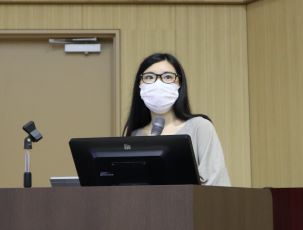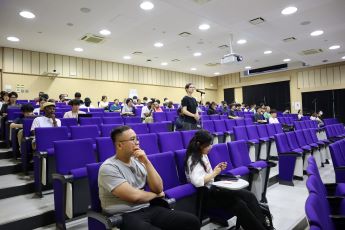- Home
- Student Activity
- Student Monthly Progress #5
The 5th Student Monthly Progress was held on July 28th, 2023.
Three students introduced their research.
【Presenter】
1. HIRAI Anri:Laboratory of Toxicology
<Neonicotinoid-induced changes in brain monoamines and behavior>
2. HUYNH Loc Tan:Laboratory of Microbiology
<Generation and efficacy of chimeric virus derived from vGPE- vaccine strain for classical swine fever marker vaccine>
3. SUWANTHADA Pondpan:Division of Bioresources
<Interaction between QnrB19 and DNA-DNA gyrase complex of Salmonella Typhimurium>
【Chair】
MUNYEKU Yannick Bazitama:Division of Global Epidemiology
SOE NYEIN CHAN:Laboratory of Toxicology
❖Chairperson's Report❖
Three students introduced their research during the 5th Student Monthly Progress Meeting.
In her research, HIRAI Anri investigated the combination of behavioral tests and monoamine neurotransmitter level monitoring as an efficient alternative to detect neonicotinoid-induced abnormalities that are not accompanied by pathological changes. She administered acetamiprid (ACE) orally to C57BL/6 mice and conducted the elevated zero maze test (EZM) 30 minutes later. After that, she sampled mice brains in the olfactory bulb, hippocampus, and striatum and determined monoamine levels in each region using liquid chromatography-mass spectrometry. Exposed mice displayed a trend towards increased anxiety-like behavior and decreased activity than non-exposed mice. In addition, monoamine concentrations were significantly increased, most likely due to exposure to ACE. These results are expected to clarify the ACE effect's mechanisms in exposed mammals.
HUYNH Loc Tan’s research aims to provide a reliable immunological marker for differentiating CSF-infected animals from vaccinated ones. Using reverse genetics, he successfully generated chimeric viruses (vGPE-/PhoPeV Erns) derived from the vGPE- vaccine strain and assessed the vaccine efficacy of each chimera. The generated chimeric viruses propagated well in swine kidney cell lines with titers as high as vGPE-/PAPeV Erns and vGPE- and were safe after inoculation in pigs inducing comparable immunogenicity. In addition, the results suggest that the vGPE- genome can bear the substitution of complete PhoPeV Erns without affecting chimera immunogenicity since the E2 protein is the primary inducer of neutralizing antibody production. Further studies will be conducted to evaluate the serological discrimination property of the generated chimera as vaccine marker candidates.
Finally, SUWANTHADA Pondpan introduced her research on the interaction between QnrB19 and the DNA-DNA gyrase complex of Salmonella Typhimurium. QnrB19 is a pentapeptide protein encoded by the qnrB19 gene, a member of the Plasmid-Mediated Quinolone Resistance (PMQR) genes. Several studies have revealed that QnrB19 is a critical component that interacts with mutant DNA gyrase, leading to higher quinolone resistance. Yet, the specific mechanism of this interaction is not fully understood. Pondpan’s study aims to elucidate the interaction of QnrB19 with the DNA-DNA gyrase complex of S. Typhimurium. Through in vitro experiments, she has shown that QnrB19 can bind with DNA gyrase and complement DNA gyrase activity, therefore protecting the regular activity of DNA gyrase against inhibition by ciprofloxacin and moxifloxacin. These results are essential in understanding the mechanism and dynamic of QnrB19 resistance.
This meeting provided valuable insights into research conducted by fellow PhD students in toxicology, virology, and bacteriology. Through this activity, students are expected to get familiar with research activities beyond their interests and cultivate a collaborative research mind which is critical as a zoonosis control expert and a chemical hazard control expert.





